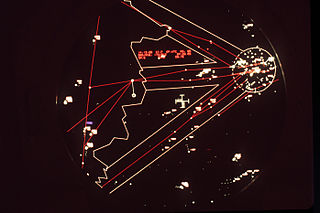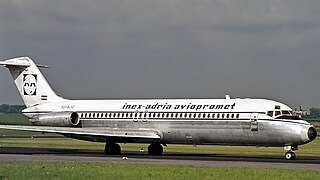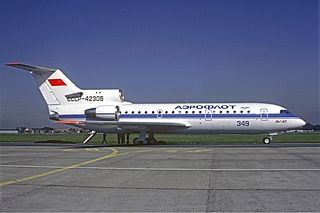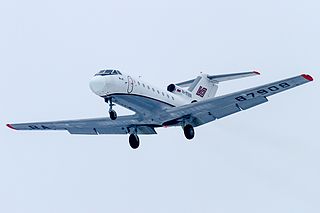
American Airlines Flight 383 was a nonstop flight from New York City to Cincinnati on November 8, 1965. The aircraft was a Boeing 727, with 57 passengers, and 5 crew on board. The aircraft crashed on final approach to the Cincinnati/Northern Kentucky International Airport located in Hebron, Kentucky, United States. Only three passengers and one flight attendant survived the crash.

During the Cold War era (1945–1991), the West Berlin air corridors, also known as the Berlin corridors and control zone, were three regulated airways for civil and military air traffic of the Western Allies between West Berlin and West Germany passing over East Germany's territory. The corridors and control zone were physically centered on and under control of the all-Allied Berlin Air Safety Center (BASC) in West Berlin. The airspace within these corridors was used by US, UK and French-registered non-combat aircraft belonging to these countries' armed forces and airlines operated by pilots holding those countries' passports. In addition, it was also used by LOT Polish Airlines for regular scheduled services from Warsaw to London and Paris via Schönefeld Airport to the south of East Berlin.

China General Aviation Flight 7552 was a China General Aviation flight from Nanjing Dajiaochang Airport to Xiamen Gaoqi International Airport. On July 31, 1992, the Yakovlev Yak-42D overran runway 06 during takeoff and impacted an embankment at 210 kilometres per hour, 420 metres (1,380 ft) from the threshold.

On 11 August 1979, a mid-air collision occurred over the Ukrainian SSR, near the city of Dniprodzerzhynsk. The aircraft involved were both Tupolev Tu-134As on scheduled domestic passenger flights, operated by Aeroflot. All 178 people aboard both aircraft died in the accident. The Soviet aviation board investigating the accident concluded that the crash was caused by "mistakes and violations" made by air traffic controllers.

On 14 March 1972, Sterling Airways Flight 296 crashed into a mountain ridge on approach to Dubai in Al Hail, Fujairah, United Arab Emirates. Flight 296 was a charter flight from Colombo to Copenhagen with stops in Bombay, Dubai, and Ankara. All 112 passengers and crew on board died in the crash which was attributed to pilot error. The flight was operated by a Sud Aviation Caravelle, registration OY-STL. To date, it is the deadliest air disaster to involve a Caravelle and the deadliest air disaster in the history of the United Arab Emirates along with Gulf Air Flight 771.

Aerosvit Flight 241 (VV241/EW241) was a scheduled international passenger flight from the Ukrainian city of Odesa to Thessaloniki, Greece. On 17 December 1997, the Yakovlev Yak-42 operating the flight registered as UR-42334 flew into a mountainside during a missed approach into Thessaloniki in Greece. All 70 people aboard were killed.

Inex-Adria Aviopromet Flight 450, JP 450, was an international charter flight from Tivat in the Socialist Federal Republic of Yugoslavia to Prague, Czechoslovakia which crashed in the Prague suburb of Suchdol on October 30, 1975, at 09:20 AM. The McDonnell Douglas DC-9-32 with 115 passengers and 5 crew on board descended, under Instrument Meteorological Conditions (IMC), below defined Minimum Descent Altitude (MDA) during the final approach to Prague Ruzyně Airport RWY 25, entered a gorge above Vltava river, and was unable to outclimb the rising terrain. 75 of the 120 occupants died during the crash itself while 4 others died in Hospital. The accident remains the worst aviation disaster on the Czech Republic soil.

On 4 April 2011, Georgian Airways Flight 834, a Bombardier CRJ100 passenger jet of Georgian Airways operating a domestic flight from Kisangani to Kinshasa in the Democratic Republic of Congo (DRC) crashed while attempting to land at Kinshasa Airport. The aircraft, which was chartered by the United Nations, was trying to land during a thunderstorm. Of the 33 people on board, only one person survived. The incident remains as the United Nations' deadliest aviation disaster. It is also the third-deadliest air disaster involving the CRJ100/200, behind Comair Flight 5191 and China Eastern Airlines Flight 5210.

Si Fly Flight 3275 (KSV3275) was a non-scheduled international passenger flight from the Italian capital of Rome to Pristina, Kosovo. The flight was operated by Italian airliner Si Fly using an ATR 42-300 series. On 12 November 1999, the aircraft struck a mountain during the approach to Pristina, killing everyone on board. With 24 deaths, the accident remains as the deadliest aviation disaster in Kosovo's history.

Aeroflot Flight 721 was a scheduled domestic passenger flight between Moscow and Yuzhno-Sakhalinsk in the Russian SFSR. On Wednesday, 2 September 1964, the aircraft flying this route, an Ilyushin Il-18V, crashed into the side of a hill on approach to Yuzhno-Sakhalinsk, killing 87 of the 93 people on board. At the time of the accident, it was the deadliest Il-18 crash and the deadliest aviation accident on Russian soil.

Aeroflot Flight 8641 was a Yakovlev Yak-42 airliner on a domestic scheduled passenger flight from Leningrad to Kiev. On 28 June 1982, the flight crashed south of Mazyr, Byelorussian SSR, killing all 132 people on board. The accident was both the first and deadliest crash of a Yakovlev Yak-42, and remains the deadliest aviation accident in Belarus.

Aeroflot Flight N-528 was a regular commercial flight from Odesa to Berdyansk that crashed while attempting to land in poor weather conditions.

On 9 March 2016, True Aviation Flight 21, an Antonov An-26 transport aircraft operated by True Aviation crashed 500 metres from Cox's Bazar Airport in Bangladesh, from where it had taken off shortly before. The twin-engine plane was attempting to return to the airport after experiencing an engine failure. Three of the four crew members on board were killed in the accident.

The 1976 Anapa mid-air collision was the collision of Aeroflot Flight 7957 and Aeroflot Flight S-31 on 9 September 1976, off the coast of Anapa in the Soviet Union. All 70 people on the two aircraft were killed in the crash. The primary cause of the accident was determined to be error by the air traffic controller; investigators never recovered the fuselage of the Yak-40.

Aeroflot Flight 1080 was a Soviet domestic passenger flight from Yekaterinburg, Russia, to Kostanay, Kazakhstan, that crashed at night shortly after takeoff on 7 October 1978. All 38 passengers and crew were killed in the crash which occurred when one of the engines failed due to icing during initial climb out. At the time, the crash was the second worst in the history of the Yakovlev Yak-40, which had entered operational service with Aeroflot just ten years prior.

Aeroflot Flight U-45 was a passenger flight operated by an Ilyushin Il-18 that crashed during the approach to Samarkand on Friday, 6 February 1970, resulting in the death of 92 of the 106 people on board. An investigation revealed the aircraft went below the minimum obstacle clearance altitude (MOCA) during approach to Samarkand International Airport.

Aero Trasporti Italiani Flight 12 was a domestic flight from Alghero-Fertilia Airport. On September 14, 1979, The Douglas DC-9 struck a rocky mountainside during an attempted landing, resulting in the loss of all 31 passengers and crew on board. The crash was caused by misinterpreting ATC instructions leading to the flight colliding with terrain.

The 1981 Zheleznogorsk mid-air collision was an accident involving a Yakovlev Yak-40 jet and a Mil Mi-8T helicopter, both operated by the Russian airline Aeroflot, 11 km east of Zheleznogorsk-Ilimskiy Airport, Soviet Union, on 18 September 1981. None of the combined 40 passengers and crew on either aircraft survived.



















